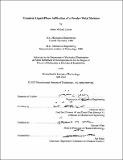Transient liquid-phase infiltration of a powder-metal skeleton
Author(s)
Lorenz, Adam Michael, 1974-
DownloadFull printable version (7.891Mb)
Other Contributors
Massachusetts Institute of Technology. Dept. of Mechanical Engineering.
Advisor
Emanuel Sachs.
Terms of use
Metadata
Show full item recordAbstract
Transient Liquid-Phase Infiltration (TLI) is a new method for densifying a powder-metal skeleton that produces a final part of homogeneous composition without significant dimensional change, unlike traditional infiltration and full-density sintering. Fabrication of direct metal parts with complex geometry is possible using TLI in conjunction with Solid Freeform Fabrication (SFF) processes such as Three-Dimensional Printing, which produce net-shape skeletons of powdered metal directly from CAD models. The infiltrant used in TLI is typically composed of the skeleton material plus a melting point depressant in order to facilitate homogenization after the liquid metal fills the void space. Parts over 20 cm tall with final compositions of Ni-4wt%Si and Ni-40wt%Cu were made by TLI from powder skeletons of pure nickel. Tensile tests after HIP treatment compared favorably with cast material of the same composition. A basic understanding of the materials system requirements for TLI and the role of various parameters was developed using nickel-silicon and nickel-copper as test cases. Upon introduction of the liquid infiltrant to the skeleton, the melting point depressant begins to diffuse into the skeleton causing isothermal solidification of the infiltrant. This solidification chokes theflow of liquid and can limit the infiltration distance. (cont.) The rate of diffusional solidification was measured via quenching experiments, compared to theory and simulations, and subsequently used to define the change in permeability of the skeleton. For various skeletons of powder sizes ranging from 60 to 300 tm, the infiltration rate was measured via mass increase and compared to the flow model. The predicted horizontal infiltration freeze-off limits were proportional to the square root of d3[gamma]/[mu]D[Beta]2 where d is the average powder diameter, [gamma] and [mu] are the infiltrant surface tension and viscosity, D is the solid diffusivity, and [beta] is a function of the solidus and liquidus concentrations. These relations can be used for selection of processing parameters and for development of new material systems.
Description
Thesis (Ph. D.)--Massachusetts Institute of Technology, Dept. of Mechanical Engineering, 2002. Includes bibliographical references (leaves 113-114). This electronic version was submitted by the student author. The certified thesis is available in the Institute Archives and Special Collections.
Date issued
2002Department
Massachusetts Institute of Technology. Department of Mechanical EngineeringPublisher
Massachusetts Institute of Technology
Keywords
Mechanical Engineering.